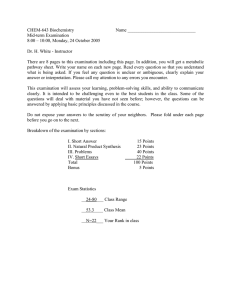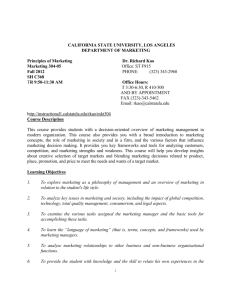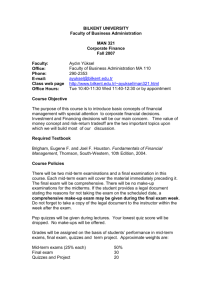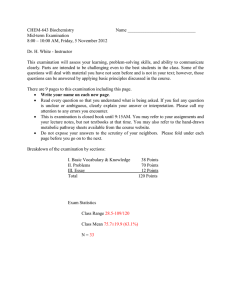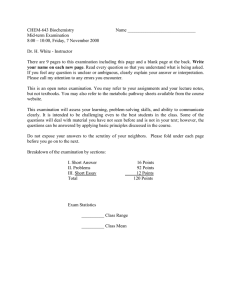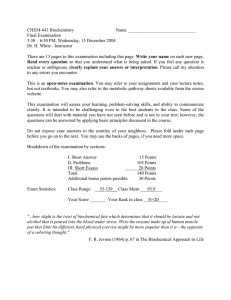CHEM-643 Biochemistry ... Mid-term Examination
advertisement
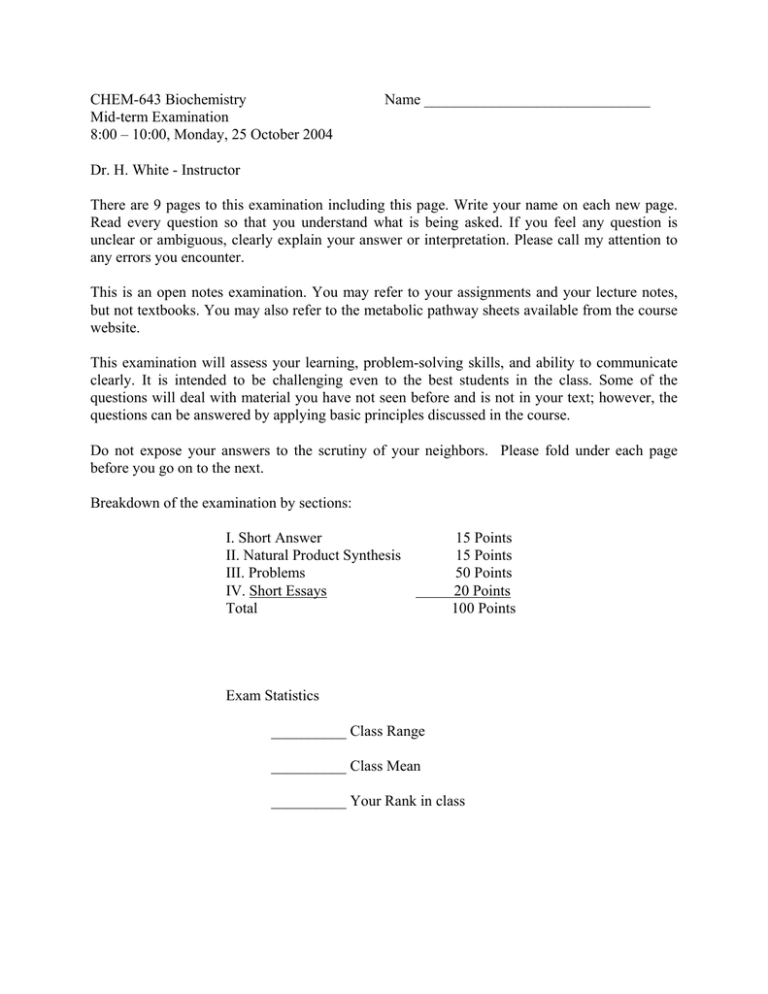
CHEM-643 Biochemistry Mid-term Examination 8:00 – 10:00, Monday, 25 October 2004 Name ______________________________ Dr. H. White - Instructor There are 9 pages to this examination including this page. Write your name on each new page. Read every question so that you understand what is being asked. If you feel any question is unclear or ambiguous, clearly explain your answer or interpretation. Please call my attention to any errors you encounter. This is an open notes examination. You may refer to your assignments and your lecture notes, but not textbooks. You may also refer to the metabolic pathway sheets available from the course website. This examination will assess your learning, problem-solving skills, and ability to communicate clearly. It is intended to be challenging even to the best students in the class. Some of the questions will deal with material you have not seen before and is not in your text; however, the questions can be answered by applying basic principles discussed in the course. Do not expose your answers to the scrutiny of your neighbors. Please fold under each page before you go on to the next. Breakdown of the examination by sections: I. Short Answer II. Natural Product Synthesis III. Problems IV. Short Essays Total 15 Points 15 Points 50 Points 20 Points 100 Points Exam Statistics __________ Class Range __________ Class Mean __________ Your Rank in class CHEM-643 Intermediary Metabolism Mid-term Examination, 25 October 2004 Page 2 Name ______________________________ Part I - Short Answer Questions (1 point each) __________________________ 1. Name of the bicyclic ring system found in folic acid and several other cofactors. __________________________ 2. Antidote for ethylene glycol poisoning. __________________________ 3. Class of PLP-dependent reactions that have a “ping-pong” mechanism. __________________________ 4. NADH in the presence of oxygen in the mitochondria is used to make ATP via this process. __________________________ 5. Name of the vitamin precursor to FAD. __________________________ 6. This cofactor helps catalyze carbon-carbon bond cleavage next to carbonyl groups. __________________________ 7. Virtually exclusive metabolic fuel for your brain. __________________________ 8. Biosynthetic precursor that provides all of the carbon in 2,4,6-trimethyl nonanoate in the dipper duck. __________________________ 9. Example of a fatty acid that is a diterpene. __________________________ 10. Enzyme in E. coli that is feedback inhibited by histidine, AMP, GMP, glycine, alanine, and glucosamine-6-P. __________________________ 11. Fatty acid precursor of prostaglandins. __________________________ 12. Group of organisms that do not make steroids. __________________________ 13. Golden Rice was engineered to make this compound. __________________________ 14. Amino acid source of methyl groups in methylation reactions. __________________________ 15. Small FeS-containing protein involved in a variety of one electron transfer reactions. CHEM-643 Intermediary Metabolism Mid-term Examination, 25 October 2004 Page 3 Name ______________________________ Part II Natural Product Biosynthesis: 1. (5 Points) Homocitrate (below) coordinates to the molybdenum in the FeMo cofactor in nitrogenase. Propose a simple, reasonable enzymatic reaction that would form homocitrate in one step from well-known common metabolic intermediates. 2. (5 Points) The major component of the sex attractant pheromone of the boll weevil, Anthonomus grandis, is grandisol, shown below. A. (1 Point) To what class of compounds does grandisol belong? B. (4 Points) In the space to the left of grandisol, draw the structure of a well-recognized, likely precursor in a way that shows its carbon-for-carbon relationship to grandisol. 3. (5 points) A recent report in Nature [429, 363 (2004)] describes the isolation and characterization of a bright red compound in hippopotamus sweat that serves as a sun screen for this virtually hairless tropical animal. The structure of hipposudoric acid is shown below. What compound, displayed in another problem in this examination, would be a likely precursor to this hipposudoric acid and account for all of the carbon atoms in it? Show why you selected the compound you did. CHEM-643 Intermediary Metabolism Mid-term Examination, 25 October 2004 Page 4 Name ______________________________ Part III Problems 1. (10 points) Certain molds produce 6-methylsalicylate from the eight-carbon, enzymebound intermediate shown below. Show either the reactions required to form the intermediate from acetyl CoA or how mechanistically the intermediate would cyclize and go on to form the product. CHEM-643 Intermediary Metabolism Mid-term Examination, 25 October 2004 Page 5 Name ______________________________ 2. The final steps in tyrosine biosynthesis in plants and some microorganisms [Z. Naturforsch 41c, 69-78 (1986); J. Bacteriol. 144, 247-257 (1980)] is shown below. The questions that follow refer to this sequence of reactions. a) (4 Points) Reaction 1 is the only example known in biochemistry of the Claisen rearrangement, a well-known reaction in organic chemistry. Reaction 3 is an oxidative decarboxylation. Choose one of these two reactions and show by pushing electrons how the reaction proceeds. b) (2 Points) What coenzyme is required for Reaction 2? (Give its name rather than an abbreviation) c) (4 Points) The coenzyme for Reaction 2 is normally associated with a particular amino acid in the enzyme’s active site. How could one chemically link that amino acid residue irreversibly with the coenzyme? (Hint: Problem Set 2) Explain. d) (3 Points) What amino acid cosubstrate would you expect to be the amino group donor in Reaction 2? Explain your reasoning? e) (5 Points) NADPH is generated in the final step. Does this make sense? Explain your answer. CHEM-643 Intermediary Metabolism Mid-term Examination, 25 October 2004 Page 6 Name ______________________________ The catabolic pathway for Phenylalanine and Tyrosine is shown below and is the basis for the questions that follow. A. (6 Points) What are the names of compounds A and B? What would be the next compounds, C & D, in the metabolism of each? B. (4 Points) One of the first Inborn Errors of Metabolism, Alcaptonuria, was described by Archibald Garrod over 100 years ago [Lancet 2, 1616 (1902)]. It involved a defect in enzyme 4 above. If [2 13C] phenylalanine were fed to a person with alcaptonuria, where would the labeled carbon be located in homogentisate? Circle the atom in the above figure. CHEM-643 Intermediary Metabolism Mid-term Examination, 25 October 2004 1. Page 7 Name ______________________________ (12 points) Knoop in 1905 studied the oxidation of a variety of ω-phenyl acids in rabbits. He fed 2g of each and observed a limited variety in the metabolic products excreted in the urine. His results were as follows. 1 2 3 4 5 6 7 8 9 1 0 1 1 Compound Fed C6H5-COOH C6H5-CH2-COOH C6H5-CH(OH)-COOH C6H5-CH2-CH2-COOH C6H5-CH(OH)-CH2-COOH C6H5-CO-CH2-COOH C6H5-CH=CH-CH2-COOH C6H5-CH2-CH(NH2)-COOH C6H5-CH2-CO-COOH C6H5-CH2-CH2-CH2-COOH Compound Excreted C6H5-COOH C6H5-CH2-COOH C6H5-CH(OH)-COOH C6H5-COOH C6H5-COOH C6H5-COOH C6H5-CH2-COOH None observed None observed C6H5-CH2-COOH C6H5-CH2-CH2-CH2-CH2-COOH C6H5-COOH A. (4 points) Ignoring compounds 8 & 9, explain these results in a coherent way? B. (4 points) Actually the metabolic products observed by Knoop were glycine amide derivatives of the acids shown above - hippuric acid (C6H5-CO-NH-CH2-COOH) and phenylaceturic acid (C6H5-CH2-CO-NH-CH2-COOH). Predict the enzyme reaction in which they are formed. C. (4 points) What is the common name for compound 8? How are compounds 8 and 9 interconverted metabolically? Why didn’t Knoop observe metabolic products from them? CHEM-643 Intermediary Metabolism Mid-term Examination, 25 October 2004 Page 8 Name ______________________________ Part V Essay Questions Writing reflects how you think. Among the “right answers” I will read for the following questions, some will be better than others because they show greater depth of understanding, avoid extraneous or inaccurate information, provide a more logical structure, use appropriate examples, and choose words with precision. Better quality answers will receive higher marks. Therefore organize your thoughts before you write. Strive to write not that you may be understood, but rather that you cannot possibly be misunderstood. Stream of consciousness answers are rarely well organized or clearly presented. 1. (10 Points) Virtually every child born in the United States is tested at birth for a variety of inborn errors of metabolism (genetic diseases). Among them are phenylketonuria, medium-chain acyl CoA dehydrogenase deficiency, biotinidase deficiency, branched chain ketoaciduria, galactosemia, and homocystinuria. In an informative paragraph or two illustrated with chemical structures, describe one of these diseases. Why is early detection important? CHEM-643 Intermediary Metabolism Mid-term Examination, 25 October 2004 Page 9 Name ______________________________ 2. (10 Points) Fix your attention on a carbon atom in a glucose molecule that you consumed at your last meal. In a narrative (no structures), generate a reasonable story of the fate of that carbon atom that involves muscle, liver, brain, and adipose tissue, and several different metabolic pathways before exiting as carbon dioxide.
